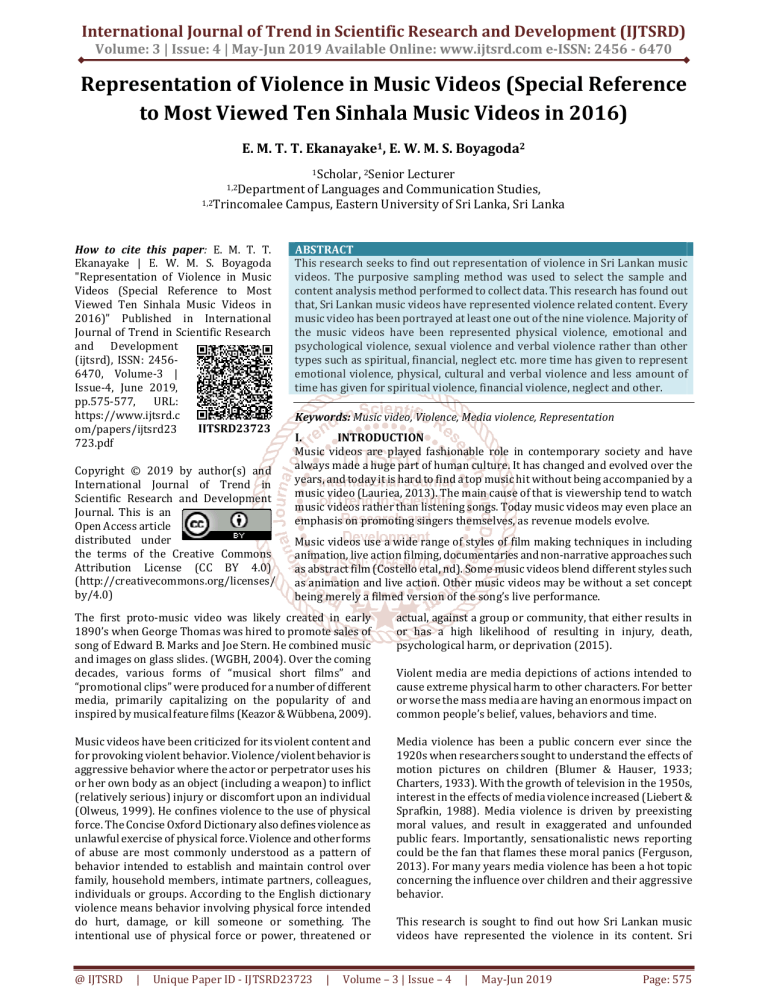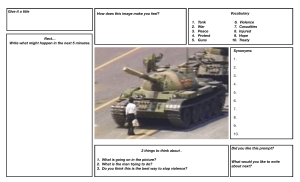
International Journal of Trend in Scientific Research and Development (IJTSRD)
Volume: 3 | Issue: 4 | May-Jun 2019 Available Online: www.ijtsrd.com e-ISSN: 2456 - 6470
Representation of Violence in Music Videos (Special Reference
to Most Viewed Ten Sinhala Music Videos in 2016)
E. M. T. T. Ekanayake1, E. W. M. S. Boyagoda2
1Scholar, 2Senior
Lecturer
of Languages and Communication Studies,
1,2Trincomalee Campus, Eastern University of Sri Lanka, Sri Lanka
1,2Department
How to cite this paper: E. M. T. T.
Ekanayake | E. W. M. S. Boyagoda
"Representation of Violence in Music
Videos (Special Reference to Most
Viewed Ten Sinhala Music Videos in
2016)" Published in International
Journal of Trend in Scientific Research
and Development
(ijtsrd), ISSN: 24566470, Volume-3 |
Issue-4, June 2019,
pp.575-577,
URL:
https://www.ijtsrd.c
IJTSRD23723
om/papers/ijtsrd23
723.pdf
Copyright © 2019 by author(s) and
International Journal of Trend in
Scientific Research and Development
Journal. This is an
Open Access article
distributed under
the terms of the Creative Commons
Attribution License (CC BY 4.0)
(http://creativecommons.org/licenses/
by/4.0)
ABSTRACT
This research seeks to find out representation of violence in Sri Lankan music
videos. The purposive sampling method was used to select the sample and
content analysis method performed to collect data. This research has found out
that, Sri Lankan music videos have represented violence related content. Every
music video has been portrayed at least one out of the nine violence. Majority of
the music videos have been represented physical violence, emotional and
psychological violence, sexual violence and verbal violence rather than other
types such as spiritual, financial, neglect etc. more time has given to represent
emotional violence, physical, cultural and verbal violence and less amount of
time has given for spiritual violence, financial violence, neglect and other.
Keywords: Music video, Violence, Media violence, Representation
I.
INTRODUCTION
Music videos are played fashionable role in contemporary society and have
always made a huge part of human culture. It has changed and evolved over the
years, and today it is hard to find a top music hit without being accompanied by a
music video (Lauriea, 2013). The main cause of that is viewership tend to watch
music videos rather than listening songs. Today music videos may even place an
emphasis on promoting singers themselves, as revenue models evolve.
Music videos use a wide range of styles of film making techniques in including
animation, live action filming, documentaries and non-narrative approaches such
as abstract film (Costello etal, nd). Some music videos blend different styles such
as animation and live action. Other music videos may be without a set concept
being merely a filmed version of the song’s live performance.
The first proto-music video was likely created in early
1890’s when George Thomas was hired to promote sales of
song of Edward B. Marks and Joe Stern. He combined music
and images on glass slides. (WGBH, 2004). Over the coming
decades, various forms of “musical short films” and
“promotional clips” were produced for a number of different
media, primarily capitalizing on the popularity of and
inspired by musical feature films (Keazor & Wübbena, 2009).
actual, against a group or community, that either results in
or has a high likelihood of resulting in injury, death,
psychological harm, or deprivation (2015).
Music videos have been criticized for its violent content and
for provoking violent behavior. Violence/violent behavior is
aggressive behavior where the actor or perpetrator uses his
or her own body as an object (including a weapon) to inflict
(relatively serious) injury or discomfort upon an individual
(Olweus, 1999). He confines violence to the use of physical
force. The Concise Oxford Dictionary also defines violence as
unlawful exercise of physical force. Violence and other forms
of abuse are most commonly understood as a pattern of
behavior intended to establish and maintain control over
family, household members, intimate partners, colleagues,
individuals or groups. According to the English dictionary
violence means behavior involving physical force intended
do hurt, damage, or kill someone or something. The
intentional use of physical force or power, threatened or
Media violence has been a public concern ever since the
1920s when researchers sought to understand the effects of
motion pictures on children (Blumer & Hauser, 1933;
Charters, 1933). With the growth of television in the 1950s,
interest in the effects of media violence increased (Liebert &
Sprafkin, 1988). Media violence is driven by preexisting
moral values, and result in exaggerated and unfounded
public fears. Importantly, sensationalistic news reporting
could be the fan that flames these moral panics (Ferguson,
2013). For many years media violence has been a hot topic
concerning the influence over children and their aggressive
behavior.
@ IJTSRD
|
Unique Paper ID - IJTSRD23723
|
Violent media are media depictions of actions intended to
cause extreme physical harm to other characters. For better
or worse the mass media are having an enormous impact on
common people’s belief, values, behaviors and time.
This research is sought to find out how Sri Lankan music
videos have represented the violence in its content. Sri
Volume – 3 | Issue – 4
|
May-Jun 2019
Page: 575
International Journal of Trend in Scientific Research and Development (IJTSRD) @ www.ijtsrd.com eISSN: 2456-6470
Lankan music video industry of it has not got a long history.
The initial music video in Sri Lanka was content with only
two shots. It was produced by Mr. Sunil Siriwardhana for
Millon Mallawarachchi’s ‘Orwaka pawena’ song (History of
music video, 2015). Sebalaneni, a musical tribute to the war
heroes of our country premiered on MTV World, New York
on May 7 the first time a Sri Lankan song which composed
and sung by Ranidu Lankage, was aired on the popular
international channel. (Sunday times 2010). The first 3D
music video in Sri Lanka is “Ranwan patata” by Devashri
(You tube, 2012).
OBJECTIVES
General objective
1. To find out the representation of violence in music
videos in Sri Lanka
Specific Objectives
1. To find out the types of violence represented in music
videos.
2. To find out the way of representing violence in music
videos.
3. To find out time allocation for violence in music videos.
II.
REVIEW OF LITERATURE
Clark, Glover, et al, (2016) have done a research on ‘An
Analysis of Violent and Sexual Content in Hip Hop Music
Videos’. A content analysis of hip hop music videos was
conducted to determine the prevalence of violent and sexual
content. Violent content included showing guns, theft, drugs,
fighting, police violence, and gang activity. Sexual content
included showing sexual encounters such as kissing and
implied sex, the image of body parts such as the cleavage,
buttocks, and pelvic region of women, and revealing clothing.
Tropeano, (2006) has done a research on Does Rap or Rock
Music Provoke Violent Behavior? He found that watching the
violent music video containing violent lyrics, aggressive
behavior, and degrading behaviors toward women did make
an individual feel and react more violently with regards to
responses to questions about fictitious scenarios.
Huesmann and Taylor, (2006) have done a research on The
Role of Media Violence in Violent Behavior. Media violence
poses a threat to public health inasmuch as it leads to an
increase in real-world violence and aggression. Research
clearly shows that, fictional television and film violence
contribute to an increase in aggression and violence, both in
the short term and across the lifespan. Television news
violence also contributes to increased violence, principally in
the form of imitative suicides and acts of aggression. Video
games are clearly capable of producing an increase in
aggression and violence in the short term, although no longterm longitudinal studies capable of demonstrating longterm effects have been conducted. The relationship between
media violence and real-world violence and aggression is
moderated by the nature of the media content and
characteristics of and social influences on the individual
exposed to that content. Still, the average overall size of the
effect is large enough to place it in the category of known
threats to public health.
METHODOLOGY
III.
In order to carry out the objective of the research, the
researcher used quantitative and qualitative methodology.
Primary data were collected through content analysis and
@ IJTSRD
|
Unique Paper ID - IJTSRD23723
|
data were collected using a coding sheet. The focus of this
research is representation of violence in music videos,
special reference to most viewed Sinhala music video in
2016. The unit of analysis in this study is the scene by scene
of music video. The researcher has used purposive sampling
method for this study as follows.
1. Adare sanwedana (Jude Rogans)
2. Amma (Jude Rogans)
3. Athi mawa rawatuwa (Shihan Mihiranga
4. Ayeth warak (Sadun perera)
5. Giniyam Rae (Shermaine Willis Ft. Iraj & Kaizer)
6. Mama Sil Bidagaththe (Iraj)
7. Man Pathanawa (Ashan Fernando)
8. Pin Madida Danne Na (Samith Sirimanna)
9. Thanikadai Thama Man (Viraj Perera) (You tube 2017).
IV.
RESULTS
According to the findings, it is revealed that Sri Lankan music
videos have represented violence related content. Every ten
music video has been used at least one type of violence. It is
found that physical, sexual, emotional and psychological,
structural, verbal, spiritual, cultural, neglect, financial
violence are represented in the music videos. Majority of the
music videos have been represented physical violence, and
emotional and psychological violence, sexual violence and
verbal violence rather than other types such as spiritual,
financial, neglect etc.
Violent content included
Each and every music video has diffesrent time allocation
and has portrayed different kind of violence. It is found that
35 percentage of time has been allocated for emotional
violence (Figure 01). For physical, cultural and verbal
violence, it has been allocated 18%, 13% and 13%
respectively. Less amount of time has been allocated for
spiritual violence, financial violence, neglect and other.
Figure1: Total time allocation for violence in selected 10
music videos in Sri Lanka
V.
CONCLUSION
At present, music hits accompany music video and
viewership also tends to watch music videos rather than
listening songs. Music videos are criticized for its violent
related content and have been influential on audience. This
research has found out that, Sri Lankan music videos have
represented violence related content. Majority of the music
videos have been represented physical violence, emotional
and psychological violence, sexual violence and verbal
violence rather than other types such as spiritual, financial,
neglect etc. more time has given to represent emotional
Volume – 3 | Issue – 4
|
May-Jun 2019
Page: 576
International Journal of Trend in Scientific Research and Development (IJTSRD) @ www.ijtsrd.com eISSN: 2456-6470
violence, physical, cultural and verbal violence and less
amount of time has given for spiritual violence, financial
violence, neglect and other.
VI.
RECOMMENDATIONS
Media representations shape understandings of the
audience. In fact, there is significant relationship between
violent behavior of the people and violence content in the
mass media messages. Therefore, it is recommended to
conduct a study on audience perception on mass media or
new media violence representation in future. A comparative
study on representation of violence in music videos in Sri
Lanka and other Asian or Europe Countries also is
recommended. Furthermore, this research can make sense of
media ethics while using violence in music videos or media
content for the producers so that they can be more careful
while using crimes in media content.
[6] History of music video. (2015 ). Retrieved March, 13,
2016,
from
http://www.slideshare.net/crosswaysfederation/musi
c-video-a-brief-history
[7] Huesmann, L. R. (1986). Psychological processes
promoting the relation between exposure to media
violence and aggressive behavior by the viewer.
Journal of Social Issues. Retrieved 25, March, 2016
from
https://deepblue.lib.umich.edu/handle/2027.42/8338
3
[8] Keazor, H & Wubbena, T . (2009). Music video.
Retrieved
March
13,2017,
from
http://archiv.ub.uniheidelberg.de/artdok/2619/1/Kea
zor_Wuebbena_Music_video_2010.pdf
[9] Lauriea,T. (2013). Music video for education and
promotion. Retrieved March 14, 2017, from http://smprovincijalat.hr/wp-content/uploads/2015/01/MusicVIdeo.pdf
REFERENCES
[1] Blumer, H., & Hauser, P. M. (1933). Movies,
delinquency, and crime. New York: Macmillan.
Retrieved
28,
March,
2017,
from
https://archive.org/details/moviesdelinquenc008269
mbp
[10] Moor, M. (n.d). Defining violence: Towards a pupil
based definition. Retrieved 11, March, 2017, from
http://schoolbullying.eu/doc/Violencedefinition.pdf
[2] Buss and Durkee, H. (2005), Influence of violent music
video on participant’s appraisals of their own
aggressiveness, Retrieved 20, March, 2017, from
http://dare.uva.nl/cgi/arno/show.cgi?fid=93984
[11] Nauser, J. W. (2015). Violence in Music Videos.
Retrieved
22,
March,
2017,
from
http://centralspace.ucmo.edu/bitstream/handle/1234
56789/400/Nauser_PSYCHOLOGY.pdf?sequence=1
[3] Clark, J. Glover, K. McClain, D. Steele. M, Jemison, D.
Brantley, A. Brockton, M. Goins, J. Flanigan, A. Mitchell,
T. Wilcox, J and Richard ,E. (2016). An Analysis of
Violent and Sexual Content in Hip Hop Music Videos.
Retrieved
12,
March,
2016,
from
http://www.juempsychology.com/wpcontent/uploads/2016/05/Clark_et_al_JUEMP_2016.p
df
[12] Olweus, D. (1999). A Brief History of the Olweus Bullying
Prevention Program. Hazeldan foundation. Retrieved
15,
March,
2017,
from
http://www.violencepreventionworks.org/public/olw
eus_history.page
[13] Street, B. (2011). Redefining Music Video, Retrieved
April, 12, 2016, from http://danmoller.com/wp
content/uploads/2011/03/Dan_Moller_-_
Redefining_Music_Video.pdf
[4] Costello. (n.d). Codes and convention of music video,
Retrieved
March,
15,
2017,
from
[14] Vernallis, C. (1998). Music video theory, Retrieved
https://portal.sd72.bc.ca/class/grqcsah/music%20vid
March,
15,
2017,
from
eo/Assignment%20Resources/Intro%20https://www.slideshare.net/paypal12345678/carol%20Codes%20and%20Conventions%20of%20Music
vernallis-music-video-theory
%20Videos/PDF%20Music%20Videos%20Codes%20a
nd%20Conventions.pdf
[15] WGBH Educational Foundation. (2004). WayBack .
Tech 1900, Retrieved March 19, 2017, from
[5] Ferguson, C. J., & Kilburn, J. (2009). The public health
http://pbskids.org/wayback/tech1900/music/index.h
risks of media violence: A meta-analytic review. Journal
tml
of Pediatrics, 154, 759-763. Doi: 10.1037/a0018566.
Retrieved
15,
March,
2017,
from
https://www.ncbi.nlm.nih.gov/pubmed/19230901
@ IJTSRD
|
Unique Paper ID - IJTSRD23723
|
Volume – 3 | Issue – 4
|
May-Jun 2019
Page: 577



